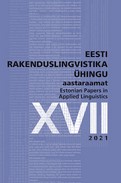ACQUISITION OF DIMINUTIVES IN TYPOLOGICALLY DIFFERENT LANGUAGES: EVIDENCE FROM RUSSIAN AND ESTONIAN
ACQUISITION OF DIMINUTIVES IN TYPOLOGICALLY DIFFERENT LANGUAGES: EVIDENCE FROM RUSSIAN AND ESTONIAN
Author(s): Victoria V. Kazakovskaya, Reili ArgusSubject(s): Morphology, Semantics, Language acquisition, Comparative Linguistics, Finno-Ugrian studies, Eastern Slavic Languages
Published by: Eesti Rakenduslingvistika Ühing (ERÜ)
Keywords: derivation; nouns; word formation; diminutives; suffixes; first language acquisition; child speech; child-directed speech; Estonian; Russian;
Summary/Abstract: The comparative paper considers diminutives at the early stages of development based on the longitudinal data of typically developing monolingual children, aged up to three years old, acquiring languages which are different in terms of diminutive systems, i.e. rich (in Russian) and poor (in Estonian). The impact of such factors as word formation and inflectional productivity, transparency, input frequency and semantic diversity on the acquisition of diminutives is discussed. From these factors, word formation and inflectional productivity are considered to have the most evident impact on the acquisition of diminutives in both languages. Being a powerful trigger for the development of early derivation and morphology, diminutives are prominent at the beginning of the acquisition of derivation in Estonian as the only derivation category, whereas they develop constantly alongside other derivatives in Russian.
Journal: Eesti Rakenduslingvistika Ühingu aastaraamat
- Issue Year: 2021
- Issue No: 17
- Page Range: 81-97
- Page Count: 17
- Language: English

